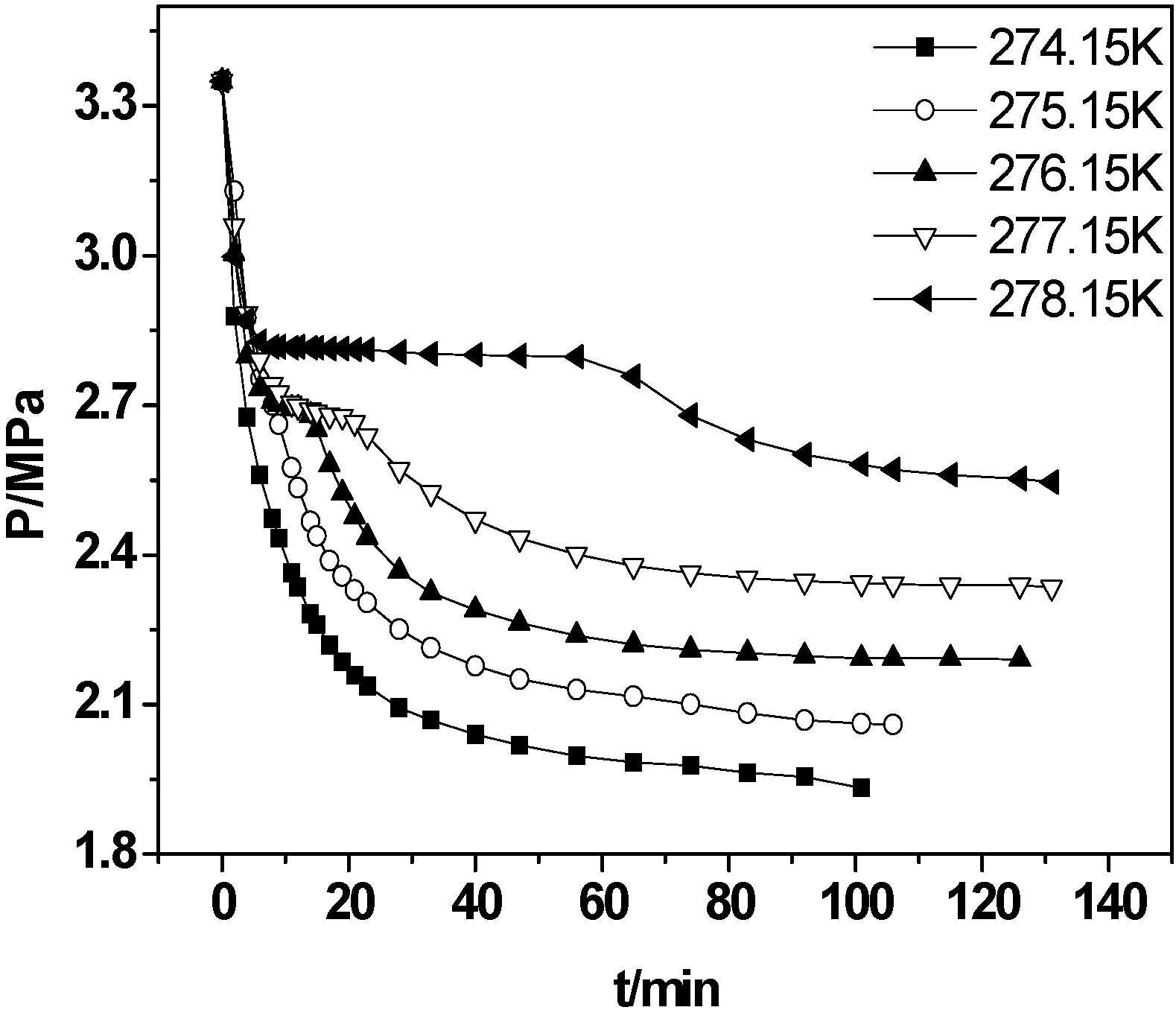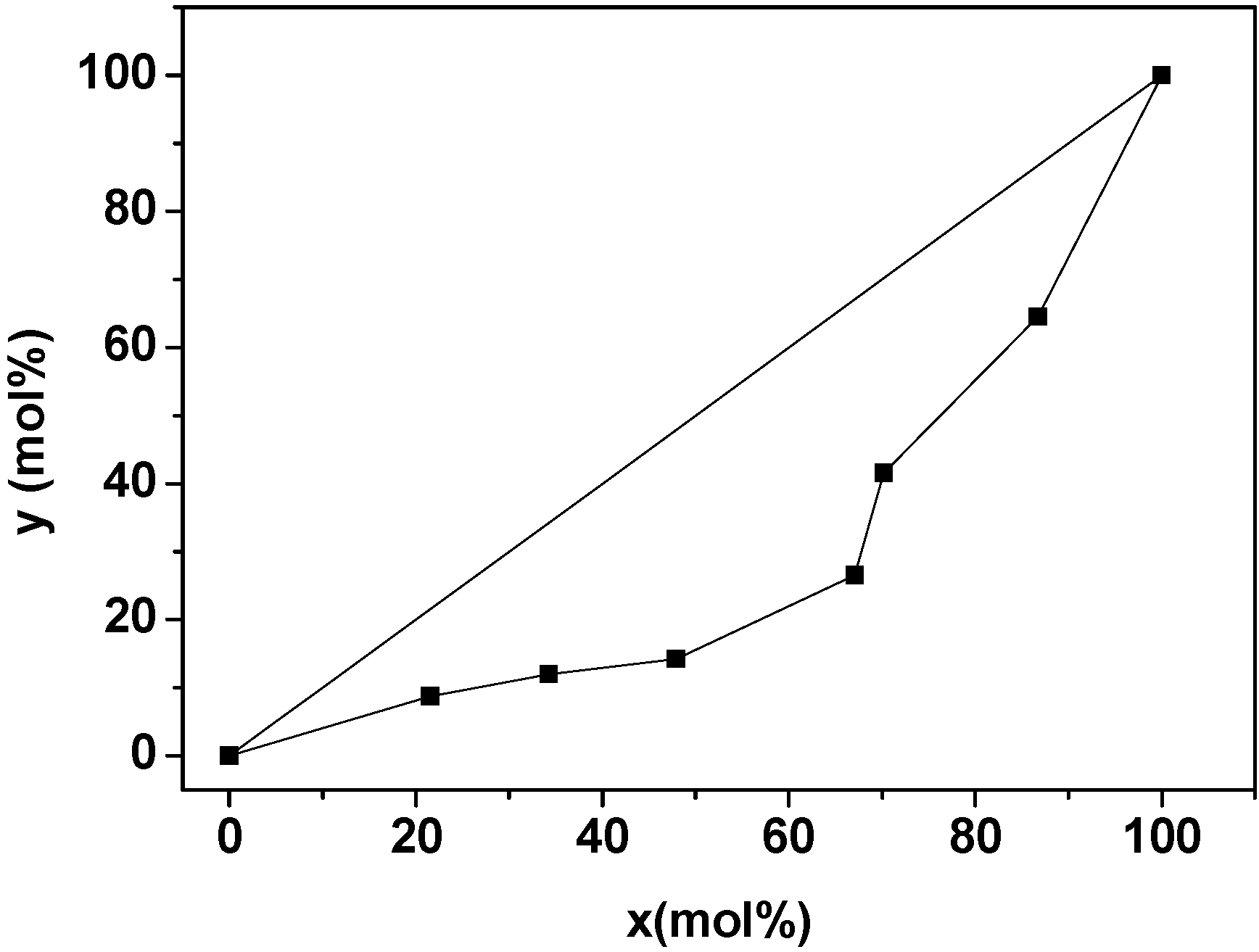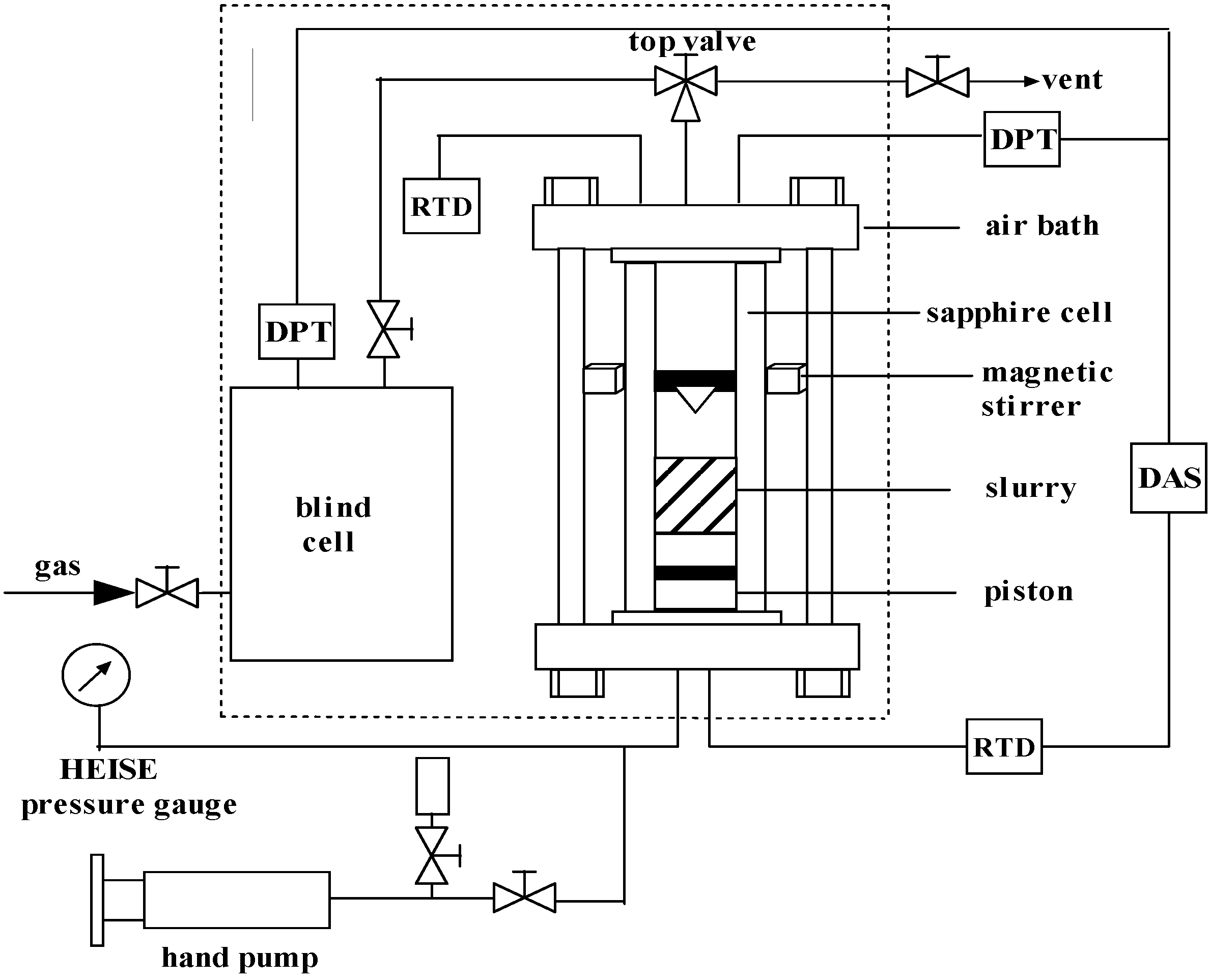Ethylene Separation via Hydrate Formation in W/O Emulsions
Abstract
:1. Introduction
2. Results and Discussion
| P0/MPa | PE/MPa | PE’/MPa | Φ | y1 | x1 | R/mol% | S |
|---|---|---|---|---|---|---|---|
| 2.2 | 1.65 | 1.55 | 53 | 19.02 | 53.63 | 57.00 | 4.92 |
| 3.4 | 1.83 | 1.74 | 80 | 14.19 | 47.74 | 75.18 | 5.53 |
| 4.2 | 2.38 | 1.81 | 109 | 12.77 | 46.50 | 79.19 | 5.94 |
| 4.3 | 2.17 | 1.85 | 80 | 11.96 | 45.28 | 81.87 | 6.09 |
| 5.0 | 2.31 | 1.90 | 80 | 10.99 | 43.27 | 85.07 | 6.18 |
| 5.2 | 3.63 | 1.65 | 142 | 16.23 | 50.75 | 67.06 | 5.31 |
| P0/MPa | PE/MPa | PE’/MPa | y1 | x1 | R/mol% | S |
|---|---|---|---|---|---|---|
| 3.4 | 1.83 | 1.74 | 14.19 | 47.74 | 75.18 | 5.53 |
| 4.3 | 2.17 | 1.85 | 11.96 | 45.28 | 81.87 | 6.09 |
| 5.0 | 2.31 | 1.90 | 10.99 | 43.27 | 85.07 | 6.18 |
| 5.4 | 2.36 | 1.98 | 9.61 | 40.41 | 89.28 | 6.38 |
| PE/MPa | T/K | y1 | x1 | R/mol% | S |
|---|---|---|---|---|---|
| 1.83 | 274.15 | 14.19 | 47.74 | 75.18 | 5.53 |
| 1.96 | 275.15 | 16.03 | 48.02 | 70.12 | 4.84 |
| 2.09 | 276.15 | 17.21 | 49.59 | 65.55 | 4.73 |
| 2.10 | 277.15 | 18.66 | 51.19 | 59.75 | 4.57 |
| 2.29 | 278.15 | 19.69 | 52.29 | 55.42 | 4.47 |
| PE/MPa | QW/% | y1 | x1 | R/mol% | S |
|---|---|---|---|---|---|
| 1.88 | 10 | 17.04 | 49.04 | 66.43 | 4.68 |
| 1.77 | 15 | 15.22 | 48.68 | 71.88 | 5.28 |
| 1.73 | 20 | 14.57 | 48.28 | 73.85 | 5.47 |
| 1.71 | 30 | 14.19 | 47.74 | 75.18 | 5.53 |
| P0/MPa | PE/MPa | y1 | x1 | R/mol% | S |
|---|---|---|---|---|---|
| 4.2 | 2.46 | 13.13 | 45.68 | 79.08 | 5.56 |
| PE/MPa | Φ (v/v) | Z1 | y1 | x1 | R/mol% | S |
|---|---|---|---|---|---|---|
| 2.34 | 75 | 13.19 | 8.71 | 21.53 | 57.08 | 2.88 |
| 2.20 | 77 | 20.84 | 11.97 | 34.28 | 65.39 | 3.83 |
| 1.93 | 80 | 30.08 | 14.19 | 47.95 | 75.04 | 5.57 |
| 1.77 | 85 | 48.43 | 26.53 | 67.04 | 76.83 | 5.63 |
| 1.46 | 103 | 61.22 | 41.57 | 70.17 | 78.75 | 3.31 |
| 1.48 | 112 | 80.44 | 64.52 | 86.73 | 76.38 | 3.49 |


2.1. Effect of Initial Gas-Liquid Volume Ratio and Pressure
2.2. Effect of Temperature
2.3. Effect of Water Cuts
2.4. Effect of Gas Compositions
3. Experimental Section
3.1. Experimental Apparatus

3.2. Materials and Preparation of Samples
3.3. Experimental Procedures
3.4. Experimental Data Processing
4. Conclusions
Acknowledgments
Author Contributions
Conflicts of Interest
References
- Baker, R.W. Future directions of membrane gas separation technology. Ind. Eng. Chem. Res. 2002, 41, 1393–1411. [Google Scholar] [CrossRef]
- He, Y.; Zhang, Z.; Xiang, S.; Wu, H.; Fronczek, F.R.; Zhou, W.; Krishna, R.; O’Keeffe, M.; Chen, B. High separation capacity and selectivity of C2 hydrocarbons over methane within a microporous metal-organic framework at room temperature. Chem. Eur. J. 2012, 18, 1901–1904. [Google Scholar] [CrossRef] [PubMed]
- Li, K.; Olson, D.H.; Seidel, J.; Emge, T.J.; Gong, H.; Zeng, H.; Li, J. Zeolitic imidazolate frameworks for kinetic separation of propane and propene. J. Am. Chem. Soc. 2009, 131, 10368–10369. [Google Scholar] [CrossRef] [PubMed]
- Sloan, E.D. Clathrate Hydrates of Natural Gases, 2nd ed.; Marcel Dekker: New York, NY, USA, 1998. [Google Scholar]
- Zhang, L.W.; Chen, G.J.; Guo, X.Q.; Sun, C.Y.; Yang, L.Y. The partition coefficients of ethane between vapor and hydrate phase for methane + ethane + water and methane + ethane + THF + water systems. Fluid Phase Equilib. 2004, 225, 141–144. [Google Scholar] [CrossRef]
- Zhang, L.W.; Chen, G.J.; Sun, C.Y.; Fan, S.S.; Ding, Y.M.; Wang, X.L.; Yang, L.Y. The partition coefficients of ethylene between hydrate and vapor for methane + ethylene + water and methane + ethylene + SDS + water systems. Chem. Eng. Sci. 2005, 60, 5356–5362. [Google Scholar] [CrossRef]
- Naeiji, P.; Mottahedin, M.; Varaminian, F. Separation of methane-ethane gas mixtures via gas hydrate formation. Sep. Purif. Technol. 2014, 123, 139–144. [Google Scholar] [CrossRef]
- Kang, S.P.; Lee, H. Recovery of CO2 from flue gas using gas hydrate: Thermodynamic verification through phase equilibrium measurements. Environ. Sci. Technol. 2000, 34, 4397–4400. [Google Scholar] [CrossRef]
- Li, X.S.; Xu, C.G.; Chen, Z.Y.; Cai, J. Synergic effect of cyclopentane and tetra-n-butyl ammonium bromide on hydrate-based carbon dioxide separation from fuel gas mixture by measurements of gas uptake and X-ray diffraction patterns. Int. J. Hydrog. Energy 2012, 37, 720–727. [Google Scholar] [CrossRef]
- Zhong, D.L.; Englezos, P. Methane separation from coal mine methane gas by tetra-n-butyl ammonium bromide semiclathrate hydrate formation. Energy Fuels 2012, 26, 2098–2106. [Google Scholar] [CrossRef]
- Kamata, Y.; Yamakoshi, Y.; Ebinuma, T.; Oyama, H.; Shimada, W.; Narita, H. Hydrogen sulfide separation using tetra-n-butyl ammonium bromide semi-clathrate (TBAB) hydrate. Energy Fuels 2005, 19, 1717–1722. [Google Scholar] [CrossRef]
- Cha, I.; Lee, S.; Lee, J.D.; Lee, G.W.; Seo, Y. Separation of SF6 from gas mixtures using gas hydrate formation. Environ. Sci. Technol. 2010, 44, 6117–6122. [Google Scholar] [CrossRef] [PubMed]
- Tajima, H.; Nagata, T.; Abe, Y.; Yamasaki, A.; Kiyono, F.; Yamagiwa, K. HFC-134a hydrate formation kinetics during continuous gas hydrate formation with a kenics static mixer for gas separation. Ind. Eng. Chem. Res. 2010, 49, 2525–2532. [Google Scholar] [CrossRef]
- Wang, X.L.; Chen, G.J.; Yang, L.Y.; Zhang, L.W. Study on the recovery of hydrogen from refinery (hydrogen + methane) gas mixtures using hydrate technology. Sci. China Ser. B 2008, 51, 171–178. [Google Scholar] [CrossRef]
- Liu, H.; Mu, L.; Liu, B.; Zhang, X.X.; Wang, J.; Wang, B.; Sun, C.Y.; Yang, L.Y.; Wang, H.; Xiao, P.; et al. Experimental studies of the separation of C2 compounds from CH4 + C2H4 + C2H6 + N2 gas mixtures by absorption-hydration hybrid method. Ind. Eng. Chem. Res. 2013, 52, 2707–2713. [Google Scholar] [CrossRef]
- Liu, H.; Mu, L.; Wang, B.; Liu, B.; Wang, J.; Zhang, X.X.; Sun, C.Y.; Chen, J.; Jia, M.L.; Chen, G.J. Separation of ethylene from refinery dry gas via forming hydrate in w/o dispersion system. Sep. Purif. Technol. 2013, 116, 342–350. [Google Scholar] [CrossRef]
- Chen, G.J.; Guo, T.M. Thermodynamic modeling of hydrate formation based on new concepts. Fluid Phase Equilib. 1996, 122, 43–65. [Google Scholar] [CrossRef]
- Van Denderen, M.; Ineke, E.; Golombok, M. CO2 removal from contaminated natural gas mixtures by hydrate formation. Ind. Eng. Chem. Res. 2009, 48, 5802–5807. [Google Scholar] [CrossRef]
- Peng, B.Z.; Chen, J.; Sun, C.Y.; Dandekar, A.; Guo, S.H.; Liu, B.; Mu, L.; Yang, L.Y.; Li, W.Z.; Chen, G.J. Flow characteristics and morphology of hydrate slurry formed from (natural gas + diesel oil/condensate oil + water) system containing anti-agglomerant. Chem. Eng. Sci. 2012, 84, 333–344. [Google Scholar] [CrossRef]
© 2015 by the authors; licensee MDPI, Basel, Switzerland. This article is an open access article distributed under the terms and conditions of the Creative Commons Attribution license (http://creativecommons.org/licenses/by/4.0/).
Share and Cite
Pan, Y.; Liu, H.; Li, Z.; Liu, B.; Ma, Q.; Chen, G.; Sun, C.; Yang, L.; Gao, X. Ethylene Separation via Hydrate Formation in W/O Emulsions. Energies 2015, 8, 4871-4881. https://doi.org/10.3390/en8064871
Pan Y, Liu H, Li Z, Liu B, Ma Q, Chen G, Sun C, Yang L, Gao X. Ethylene Separation via Hydrate Formation in W/O Emulsions. Energies. 2015; 8(6):4871-4881. https://doi.org/10.3390/en8064871
Chicago/Turabian StylePan, Yong, Huang Liu, Zhi Li, Bei Liu, Qinglan Ma, Guangjin Chen, Changyu Sun, Lanying Yang, and Xueteng Gao. 2015. "Ethylene Separation via Hydrate Formation in W/O Emulsions" Energies 8, no. 6: 4871-4881. https://doi.org/10.3390/en8064871
APA StylePan, Y., Liu, H., Li, Z., Liu, B., Ma, Q., Chen, G., Sun, C., Yang, L., & Gao, X. (2015). Ethylene Separation via Hydrate Formation in W/O Emulsions. Energies, 8(6), 4871-4881. https://doi.org/10.3390/en8064871






